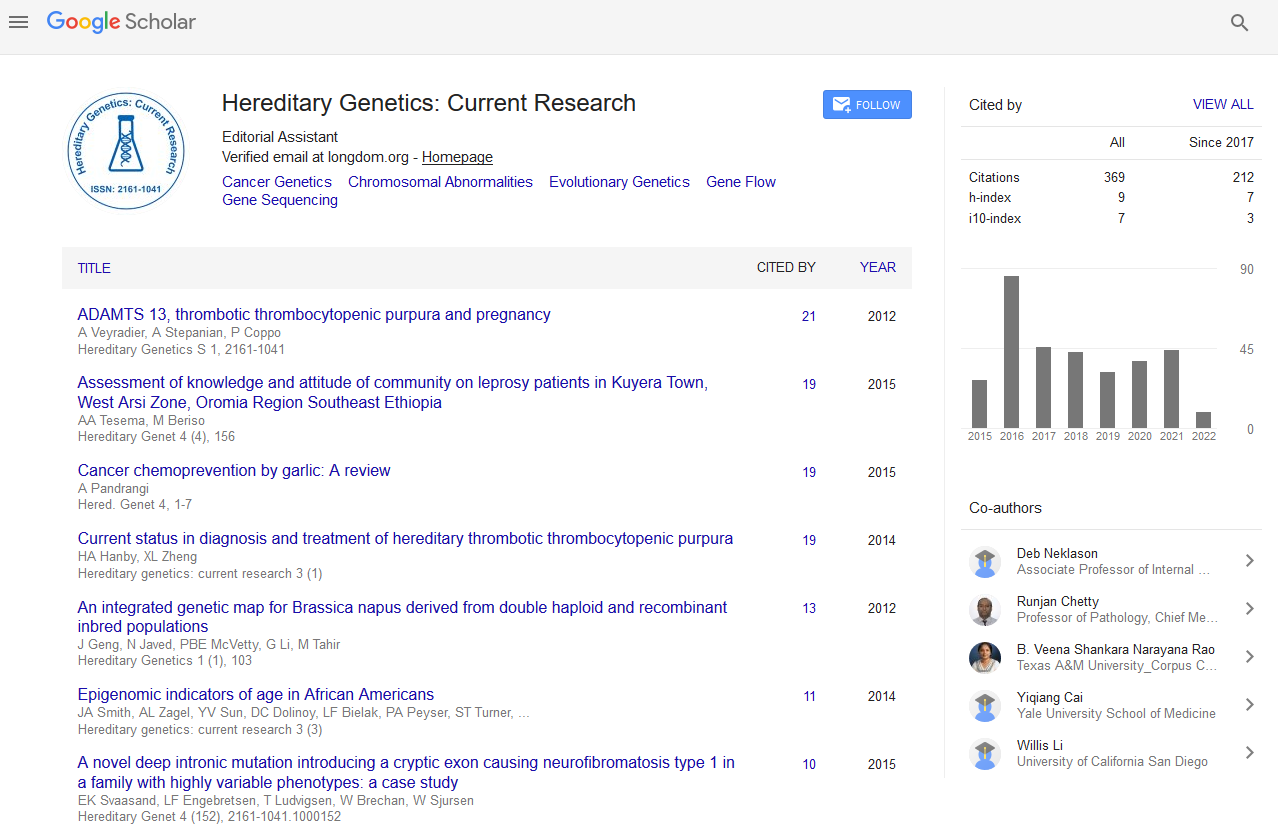PMC/PubMed Indexed Articles
Indexed In
- Open J Gate
- Genamics JournalSeek
- CiteFactor
- RefSeek
- Hamdard University
- EBSCO A-Z
- NSD - Norwegian Centre for Research Data
- OCLC- WorldCat
- Publons
- Geneva Foundation for Medical Education and Research
- Euro Pub
- Google Scholar
Useful Links
Share This Page
Journal Flyer

Open Access Journals
- Agri and Aquaculture
- Biochemistry
- Bioinformatics & Systems Biology
- Business & Management
- Chemistry
- Clinical Sciences
- Engineering
- Food & Nutrition
- General Science
- Genetics & Molecular Biology
- Immunology & Microbiology
- Medical Sciences
- Neuroscience & Psychology
- Nursing & Health Care
- Pharmaceutical Sciences
Emerging role of histone lysine methyltransferase SETDB1 and repressive histone marks H3K9me3, H4K20me3 and H3K4me3 in pediatric brain tumors
4th International Congress on Epigenetics & Chromatin
September 03-05, 2018 | London, UK
Klonou A, Gargalionis A, Korkolopoulou P, Themistocleous M, Papavassiliou A G, Sgouros S and Piperi C
National and Kapodistrian University of Athens, Greece
Agia Sofia Childrens Hospital, Greece
Mitera Hospital, Greece
Posters & Accepted Abstracts: Hereditary Genet Curr Res
Abstract:
Statement of the Problem: Brain tumors are regarded as the most prevalent solid neoplasms in children and the principal reason of death in this population. Chromatin remodeling alterations such as histone methylation induced by their respective histone methyltransferases are considered to have a prognostic value in gliomagenesis and in pediatric gliomas onset. The aim of the study was to investigate the differential expression of repressive histone marks H3K9me3, H4K20me3, H3K4me3 and linker histone H1x in pediatric gliomas. In addition, expression of lysine N-methyltransferases SETDB1 and the enhancer of zeste homolog 2 (EZH2) was evaluated. Methodology & Theoretical Orientation: Archival human glioma tissues and normal brain samples were provided by the Neurosurgery Departments of ???Mitera??? and ???Agia Sophia??? Pediatric Hospitals and the study was approved by the University of Athens, Medical School Ethics Committee. Protein expression was evaluated immunohistochemically as H-score (intensity multiplied with cell percentage, 0???300) in 36 pediatric tumor samples (30 astrocytomas grade II-III, 6 glioblastomas; age 3???14 years old; 23 males, 13 females) and in five samples of normal brain tissue. Findings: Increased nuclear staining of H3K9me3 and H4K20me3 repressive marks was observed in astrocytomas (median H-score 298 and 295, respectively). Moderate nuclear staining was obtained for H3K4me3 and SETDB1 (median H-score 190 and 120 respectively), whereas EZH2 and H1x presented no significant nuclear expression. A positive association of H3K9me3 with H3K4me3 histone marks was observed (p=0.043). SETDB1 staining was significantly elevated in males as compared to female children (p=0.007) and tended to be higher in glioblastomas compared to astrocytomas II-III (p=0.05). Conclusion & Significance: These findings indicate the possible involvement of H3K9me3, H4K20me3 and H3K4me3 histone marks in the pathogenesis of pediatric gliomas. The histone methyltransferase SETDB1 was found to play a significant role in modulating gene expression, possibly by inducing H3K9me3 epigenetic mark. Future studies validating these chromatin remodeling changes in larger cohorts are needed along with elucidation of the underlying molecular mechanisms for potential therapeutic targeting. Recent Publications: 1. Klonou A, Spiliotakopoulou D, Themistocleous M S, Piperi C and Papavassiliou A G (2018) Chromatin remodeling defects in pediatric brain tumors. Ann Transl Med. 6(12):248. 2. Blionas A, Giakoumettis D, Klonou A, Neromyliotis E, Karydakis P, et al. (2018) Paediatric gliomas: diagnosis, molecular biology and management. Ann Transl Med. 6(12):251. 3. Klonou A, Piperi C, Gargalionis A N and Papavassiliou A G (2017) Molecular basis of pediatric brain tumors. Neuromolecular Med. 19(2???3):256???270. 4. Sepsa A, Levidou G, Gargalionis A, Adamopoulos C, Spyropoulou A, et al. (2015) Emerging role of linker histone variant H1x as a biomarker with prognostic value in astrocytic gliomas. A multivariate analysis including trimethylation of H3K9 and H4K20. PLoS One. 10(1):e0115101. 5. Spyropoulou A, Gargalionis A, Dalagiorgou G, Adamopoulos C, Papavassiliou K A, et al. (2014) Role of histone lysine methyltransferases SUV39H1 and SETDB1 in gliomagenesis: modulation of cell proliferation, migration, and colony formation. Neuromolecular Med. 16(1):70???82.
Biography :


